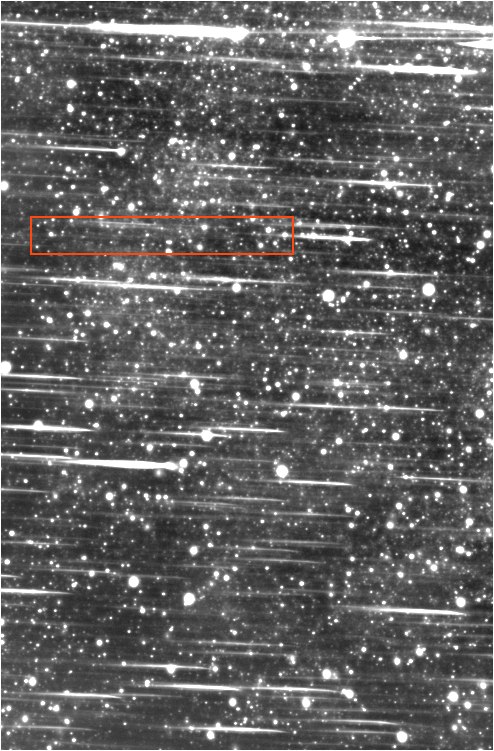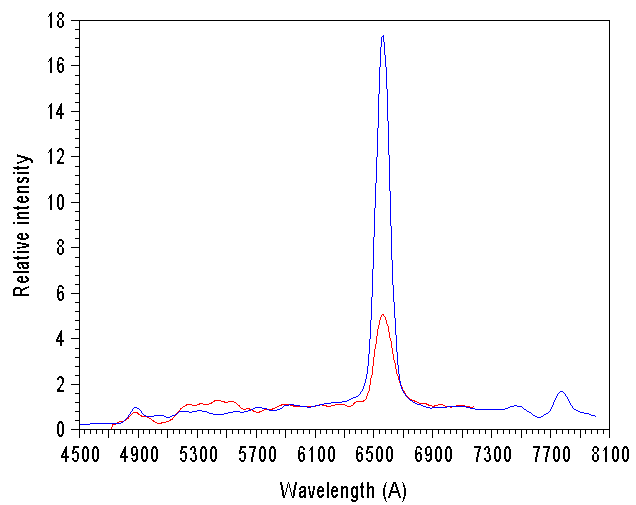 The nova Aquila 1999
spectrum
The nova Aquila 1999
spectrum
|

Contents:
1. Nova description and localisation
2. Nova with a very large
size telescope
3. Nova with a very small
size telescope
4. Nova with a medium size
telescope
The nova Aquilae 1999 (V1493) discovery has been reported by Akihiko Tago, Tsuyama, on T-max-400 film taken on July 13.6 UT with a 55-mm f/3 lens. Object is placed at R.A. = 19h07m40s, Decl. = +12° 32' .2 (Equinox 2000.0). On a film taken on July 14.5, Tago derived mag about 8.9 from the star.
K.Ayani and T.Kawabata, Bisei Astronomical Observatory
(BAO), Okayama, report: "we obtained a low resolution spectrum (range 470-680
nm) of Tago's suspected nova on July 14.6 UT with the BAO 1.01-m telescope.
Strong, broad H-alpha and H-beta lines are visible. The H-alpha line has FWMH
about 3400 km/s and equivalent width of about 50 nm.
|
|
|
|
This images have been obtained near the one-meter telescope at the Pic du Midi Observatory with an Audine Camera (CCD KAF-04001E) equipped with a 80-mm lens f/4 (July 15, 1999). The first image is the stack of 20 exposures of 2 minutes. The field of view is about 4.9°x3.3°. The second is a zoom portion of the first one, centered on the region of interest. A special processing has been applied to increase the resolution by about 50% compared to a standard stack of the frames. This processing is known as the "drizzling" technique, included in IRIS software. The colored image has been acquired in same conditions as above, but with RGB filters. Whe use the L2RGB processing. The colors balance have been adjusted using a G0 star. The nova appears red which is not surprising when looking the spectrum continuum and the presence of a strong H-alpha line (6563 angstroms).
2. Nova with a very large size telescope
We used the principle of the dispersive grating on converging optical beam with the telescope of one-meter telescope of the Pic du Midi observatory. Very thanks to Jean Lecacheux and Francois Colas for having allowed ourselves to make these experiments on this prestigious telescope.


The One-Meter Telescope of the Pic
du Midi observatory, France.
The dispersion device used is a grism configuration which consists into the association of a low-dispersive grating with a 3°52' angle prism. The grism is placed in front of the entrance focal plane of the one-meter telescope, at a distance of 50mm from the CCD surface. The grating has a dispersion of 200 lines/mm (Rainbow Optics company origin).
The one-meter telescope has a focal of 17.8 meter. The CCD is a Thomson TH7863, 288x393 pixels, with a 23 microns pixel size, cooled at -104°C. Images on July 17th have been acquired with the focal reducer (F/D=7).

Spectrum of nova Aql 1999 recorded
with the one-meter telescope. The zero order is at left.

Profile spectrum of nova Aql 1999
on July 17, 1999. The spectral response of the CCD is corrected. Observation:
Christian Buil, Francois Colas, Valérie Desnoux and Jean Lecacheux.
3. Nova with a very small size telescope
We observed the spectrum of the nova with a very minimalist spectrometer. Indeed the instrument is a simple 80-mm focal length objective...

Field of the nova Aql 99 (July 15th,
1999) since a terrace of Pic du Midi with an Audine camera equipped with a CCD
KAF-0401E and with a 80-mm focal length objective at F/2.8. A 100 grooves/mm
Jeulin grating was interposed between the CCD and the lens that gives a spectrum
for every object of the field with a dispersion value of 37 A /pixel. This image
is the result of a composite of 8 frames of 180 seconds each. The nova region
is framed by a red rectangle.



From top to bottom: the enlarged
zone of the spectral image of the nova Aquila, the same acquired region without
the grating but with a R filter, the subtraction of these two images to remove
a maximum of stars. The image without the grating was carefully degraded to
approach the resolution of the image realized image with the grating. Nevertheless
the elimination of the stars is not total, essentially because the colour indice
of stars (chromatic aberration of the optics). Nova is surrounded with a rectangle.
The H-alpha line is tracked down between two lines red lines. Note that
the chromatic coma is clearly visible.

In blue the spectrum realized at
the one-meter on July 17. In red the spectrum realized with the objective of
80 mm. The difference of intensity in the H-alpha line is not significant
considering the weak resolution of 80 mm objective spectrum. This last one was
limited to the spectral region where it is considered that the pollution by
remainder stars of the field is weak.
4. Nova with a medium size telescope

The image shows a portion in negative
of the nova V1493 spectrum realized with the R=3000 spectrograph and a 190 mm
telescope. The spectrum is centered approximately around the H-alpha line. The
spectral range is between 6280 A and 6960 A. A very wide and intense H-alpha
emission line is noted. At the time of the recording, on July 23, 1999 around
20h37 UT, the nova has a magnitude of 12, so too weak on the paper to be accessible
by the R=3000 spectrograph. It is only detected because the great emission line
(one notes besides that the continuum is faint visible, that shows the potential
of this type of spectrograph on small 190 mm telescope !). The image is the
result of the stack of 22 Audine CCD camera frames (integration time of 120
seconds for each frames).

In red, the spectral profile of
the nova. For comparison, the spectra of the Be star Beta Psc (in blue) is added,
obtained the same night in the course of my program of Be-stars survey. The
continuum was normalized to one in both cases. The star Beta Psc show a very
intense H-alpha line Alpha (6 times the level of the continuum). But it does
not have anything to see with that of nova (near 30 times !). For the nova the
Doppler velocity of the expansion gases is measured at 3470 km/sec (FWHM of
the H-alpha profile), close to that given by the professional. The line shows
complex structures that are very real and which correspond to different velocity
in the expending cloud.